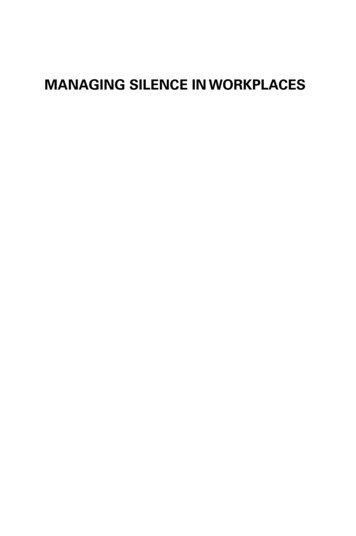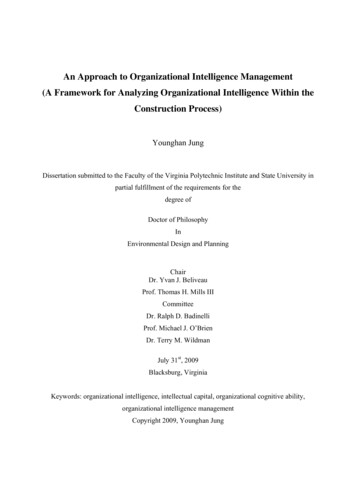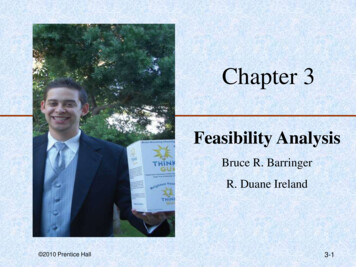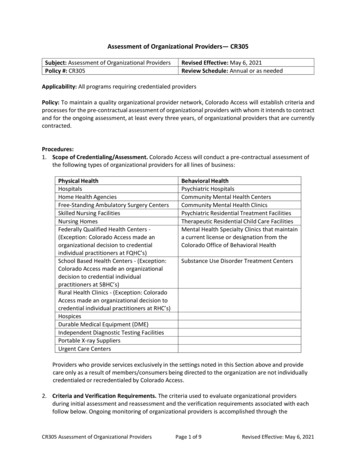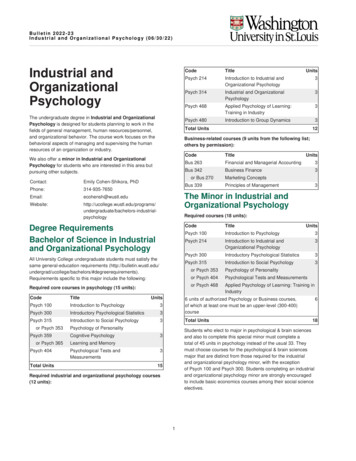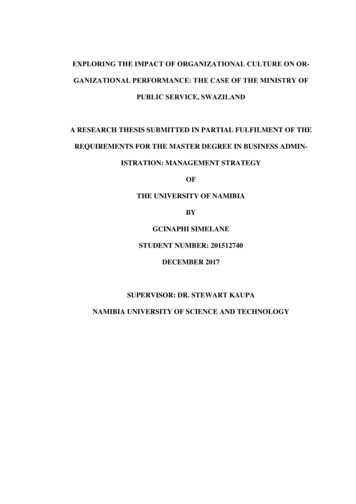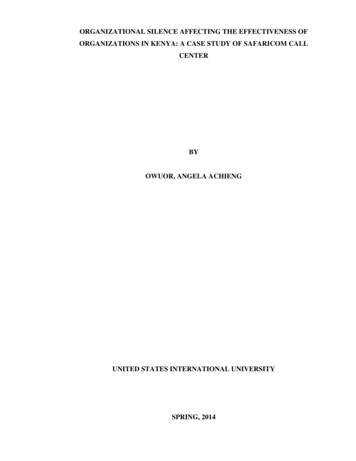
Transcription
ORGANIZATIONAL SILENCE AFFECTING THE EFFECTIVENESS OFORGANIZATIONS IN KENYA: A CASE STUDY OF SAFARICOM CALLCENTERBYOWUOR, ANGELA ACHIENGUNITED STATES INTERNATIONAL UNIVERSITYSPRING, 2014
ORGANIZATIONAL SILENCE AFFECTING THE EFFECTIVENESS OFORGANIZATIONS IN KENYA: A CASE STUDY OF SAFARICOM CALLCENTERBYOWUOR, ANGELA ACHIENGA Project Report Submitted to the Chandaria School of Business in PartialFulfillment of the Requirement for the Degree of Masters in BusinessAdministration (MBA)UNITED STATES INTERNATIONAL UNIVERSITYSPRING, 2014ii
STUDENT’S DECLARATIONI, the undersigned, declare that this is my original work and has not been submitted toany other college, institution or university other than the United States InternationalUniversity in Nairobi for academic credit.Signed:Date:Angela Owuor (ID: 636736)This project has been presented for examination with my approval as the appointedsupervisor.Signed:Date:Dr. Caren OumaSigned:Date:Dean, Chandaria School of Businessiii
COPY RIGHTNo part of this book may be reproduced in any written, electronic, recording, orphotocopying without written permission of the publisher or author. The exceptionwould be in the case of brief quotations embodied in the critical articles or reviewsand pages where permission is specifically granted by the author. Although everyprecaution has been taken to verify the accuracy of the information contained herein,the author will not assume any liability for damages that may result from the use ofinformation contained within.By Angela Owuor Copyright@2014iv
ABSTRACTThe general objective of this study was to determine organizational silence factorswhich affect the effectiveness of organizations in Kenya. To attain this, the studydetermined the causes of organizational silence and the effects of organizationalsilence that affected the effectiveness of organizations in Kenya. It also determinedthe strategies that could be used to break organizational silence in Kenya. This studyis important because it will help organizations in Kenya have an in depthunderstanding of organizational silence, in terms of the causes, effects, and strategiesof managing this phenomenon that has great effect on their effectiveness. It will alsoclearly show employees at all levels of the organization the role they play in thissilence.This study used a descriptive research design to build a profile of organizationalsilence in Kenya. It used stratified random sampling to study 92 respondents out ofthe 1617 employees at Safaricom Call Center (SCC). Primary data was collectedusing a questionnaire. A detailed research procedure was then used to ensurecredibility and accuracy of data obtained.On the causes of silence in the organization, majority of the respondents agreed thatmanagement beliefs about junior employees made managers act in ways that led tosilence. While on the causes of silence in individuals the study found that the majorityof respondents disagreed that speaking up was pointless. They suggested that therewas some level of victimization on those who spoke up which led to fear.On the effects of silence on employees, the study found that most employees were notinterested in their jobs and neither did they trust organization as much as they didwhen they joined it. However many of them felt the organization had taken steps tohave them engaged and this was consistent with their response that problems or workrelated issues were also their concerns and not just of management. Most of them feltthat the organization had taken into consideration the suggestions employees made onhow to improve effectiveness. Respondents felt that problems in the organizationcould be identified easily if all employees spoke up and that if employees spoke upv
management could get feedback to be used to improve the organization. They alsoagreed that they would be influenced into silence if they joined an organization wheresilence was prevalent.On ethical climate as a strategy that could be used to manage silence, the study foundthat respondents felt that it was wrong for employees to remain silent about wrongthings that happened in the organization but they would only speak if it was not totheir disadvantage. They suggested they would be encouraged to speak if theorganization cared more and created rules to protect them. Most of them agreed thatadequate voice mechanism had been adopted and that a verbal assurance of novictimization from the organization would be encouraging enough for employees tovoice anything.The study concluded that organizational silence was caused by the managementbeliefs as well as the organizational structure and culture. On the other hand, withinindividuals silence was caused by the individuals’ reluctance to go against the publicopinion, lack of trust in the supervisors and fear of victimization. Silence had aneffect on both the employees and the organization. On the employees it affected theirlevel of commitment and trusts while on the organization, it slowed identification andsolving of problems as well as caused development of a negative organizationalculture. According to the study, the organization could create an ethical climate as away of managing silence. They could also adopt practices that would improveemployees’ sense of trust.The study recommended that the organization should put greater measures to ensurethat a culture of silence does not take root and also adopt practices that would makeemployees feel safe to speak up for instance strict policies on how managementshould treat employees to reduce fear among them. Management should device waysof getting employees more engaged. On a positive note the study recommended thatmanagement should find out what practices contributed to the fact that employees donot experience burnouts and maintain them. The organization should also maintainthe voice mechanisms already in use because employees felt that they were good.vi
ACKNOWLEDGEMENTI would like to acknowledge my friends who together we discussed issues regardingthis study and my supervisor, Dr. Caren Ouma. I would also like to acknowledge myfamily for the many ways they supported me during this study. My sincere gratitudealso to Dr. Peter Kiriri without whose guidance this research would not have beenpossible. Most of all, I thank the Almighty God.vii
TABLE OF CONTENTSSTUDENT’S DECLARATION . iiiCOPY RIGHT . ivABSTRACT . vACKNOWLEDGEMENT . viiLIST OF ABBREVIATIONS . xLIST OF TABLES . xiLIST OF FIGURES . xiiiCHAPTER 11.0INTRODUCTION. 11.1Background of the Problem. 11.2Statement of the Problem . 41.3General Objective . 51.4Specific Objectives . 61.5Importance of the Study . 61.6Scope of the Study. 71.7Definition of Terms . 81.8Chapter Summary. 9CHAPTER 22.0LITERATURE REVIEW . 102.1Introduction . 102.2Causes of Organizational Silence . 102.3Effects of Organizational Silence . 162.4Strategies of Managing Organizational Silence . 232.5Chapter Summary. 30CHAPTER 33.0RESEARCH METHODOLOGY . 323.1Introduction . 323.2Research Design . 323.3Population and Sampling Design . 323.4Data Collection Method . 343.5Research Procedure . 353.6Data Analysis Method . 353.7Chapter Summary. 36CHAPTER 4viii
4.0RESULTS AND FINDINGS . 374.1Introduction . 374.2General Information . 374.3Causes of Organizational Silence . 404.4Effects of Organizational Silence . 474.5Strategies of Managing Organizational Silence . 544.6Chapter Summary. 58CHAPTER 55.0DISCUSSION, CONCLUSION AND RECOMMENDATIONS . 605.1Introduction . 605.2Summary . 605.3Discussion . 625.4Conclusion. 665.5Recommendation . 675.5.4 Recommendation for Further Studies . 69REFERENCES . 70APPENDICES . 75APPENDIX 1: Cover Letter . 75APPENDIX 2: Questionnaire . 76ix
LIST OF ABBREVIATIONSCEO - Chief Executive OfficerHRM - Human Resource ManagementHR- Human ResourcesLTD- LimitedSCC- Safaricom Call CentreSPSS - Statistical Package for Social Sciencex
LIST OF TABLESTable 3.1: Population Distribution .33Table 3.2: Sample Size Distribution . .34Table 4.1: It Is Normal Not To Speak Up . .40Table 4.2: Superiors Acts Show Trust . .41Table 4.3: Organizational Culture Support Speaking Up .41Table 4.4: Factors Causing Silence within Organizations . .42Table 4.5: Filter Threatening Information before Speaking . .42Table 4.6: Employees Never Victimized .43Table 4.7: Speaking Up Is Pointless . .43Table 4.8: Factors Causing Silence within Individuals . .44Table 4.9: Fear of Not Being Promoted Cause Silence . .44Table 4.10: Fear of Losing Employment Cause Silence . .45Table 4.11: Fear of Retaliation Cause Silence .45Table 4.12: Lack of Experience Cause Silence . .46Table 4.13: Lack of Authority Contribute To Silence . 46Table 4.14: Fears That Keep Employees from Speaking Up . .47Table 4.15: Daily Eagerness to Report to Work .48Table 4.16: Sense of Trust on the Organization Has Increased . .48Table 4.17: Work Related Issues as Employees Business . 49Table 4.18: The Organization Considers Suggestions .49Table 4.19: Don't Mind Management Ignoring Suggestions .50Table 4.20: Statistics on the Effects of Silence on Employees . .51Table 4.21: Problems Identification in Relation to Speaking Up . .51Table 4.22: Speaking Up Gives Management Feedback .52Table 4.23: Employees Engagement in Solving Problems .52Table 4.24: Fear of Speaking Up Effect on Others .53Table 4.25: Effects of Silence on the Organization .53Table 4.26: It Is Wrong Not To Speak Up . .54Table 4.27: Speak up if Not to Ones Disadvantage . .54Table 4.28: Employee Welfare Influence Speaking Up . 55Table 4.29: Rules/Policies Encourage Speak Up . .55xi
Table 4.30: Strategies of Managing Silence .56Table 4.31: Voice Mechanisms Are Good Enough . 56Table 4.32: T-Test on Voice Mechanisms Adopted . .57Table 4.33: Statistics on Organizational Trust . .58Table 4.34: Verbal Promises Encourage Speaking Up . .58xii
LIST OF FIGURESFig 4.1: Gender Distribution .37Fig 4.2: Highest Level of Education . . .38Fig 4.3: Age of Respondents . .39Fig 4.4: Number of Years of Work Experience . .39Fig 4.5: Job Category . .40xiii
CHAPTER 11.0 INTRODUCTION1.1 Background of the ProblemHuman Resource Management (HRM) is a field that is not very old but also one thatis very diverse. It encompasses those activities designed for and coordinates thehuman resource in the organization (Byars & Rue, 2008). Due to its wide scope, it isa synthesis of themes and concepts drawn from research in academic disciplines suchas psychology and social sciences (Price, 2011). Its major goal is to achieve theobjectives of the organization through appropriate performance levels of the humanresource.With the levels of competition soaring high each day, HRM should focus more onbeing strategic. Strategic human resource management goes beyond the majorfunctions of HRM into all aspects of managing people (Price, 2011). It focuses onmanagement decisions and the behaviors used intentionally or unintentionally, tocontrol, influence and motivate employees. Price suggested that organizations shouldlook into issues that are rare and preferably unique employee behaviors, in order togain competitive advantage. For organizations to meet future challenges, HumanResource (HR) departments must be more sophisticated than their predecessors(Byars & Rue, 2008). They need to keenly study every aspect of employee behavior.Employee behavior is indeed a very wide topic in HRM. This behavior consists ofanything an employee does in the work environment whether positive or negative(Stephen & Judge, 2007). The behaviors may directly or indirectly affect the workprocess. It is therefore very important that enough information is provided tomanagers through research projects to enable them make the right decisions whichwill enhance productivity of their organizations.Silence falls into the category of employee behavior. It is a relatively new concept inHRM, in terms of the studies done on it so far. Silence is a non-verbal behavior, anddoes not signify inaction or indicate status quo or a lack of voice (Van Dyneet al.,2003). A lot of the literature available on this topic has been borrowed partly from1
other fields like psychology and communication. This could also be explained fromthe fact that this kind of behavior was neither perceived to be bad nor good. It did notfall into the extremes of employee behavior and therefore may have been overlooked.The concept of organizational silence was first introduced by Morrison and Millikenin 2000. Tangirala and Ramanujam (2005) defined employee silence as theintentional withholding of concerns, information, or opinions by employeesconcerning important situations, issues, or events relating to their job or organization.According to Van Dyne et al. (2003) it is the employee’s motivation to withhold orexpress opinions, information, and ideas about work‐related improvements. Theseauthors agreed that employee silence is intentional. However, some of the lateststudies show that it can be an unintentional failure to communicate or a merely amatter of having nothing to say (Tangirala & Ramanujam, 2008). This is especiallyso, when it has gained overall acceptance as the norm.According to Milliken, Morrison, and Hewlin (2003), silence occurs amongemployees and managers, and employees and other employees hence keepingmembers of the organization from receiving information that may help improve theorganization. They outlined this on their research which was titled “Shades ofSilence” and further suggested that organizational silence starts from the topmanagements’ fear of receiving negative feedback, and the belief that employees areself-interested and untrustworthy. The employees then react to this and the overalleffect is a suffocating web to the organization. Just like any other kind of behavior,the motivation to remain silent can come from the employees’ perception, needs andgoals. Silence is evoked when particular stimulus is recurrently associated with orconditioned by good or bad experiences (Claydon & Beardwell, 2010).Morrison and Milliken (2000) proposed that organizational silence is a response tofear and culture of silence. However, most discussions on organizational silence seemto put culture as the ultimate cause of silence (Detert & Burris, 2007; Detert &Trevino, 2010; Greenberg & Edwards, 2009; LePine & Van Dyne, 1998). Milliken etal. (2003) further identified three additional reasons for not speaking up about2
problems, which included individual characteristics such as lack of experience andlack of tenure, organizational characteristics such as hierarchical structure andunsupportive culture, and poor relationships among employees.Tangirala and Ramanujam (2008) said that employee silence affects the wellbeing ofemployees. It increases stress and causes those involved to feel guilty. This makesthem experience psychological problems, and they may also have trouble seeing thelikelihood of change. They further discuss that most people assume thatorganizational silence only hurts the organization; however it hurts the employees asmuch as it hurts the organization. Whereas the organizations lose money because ofpoor employee performance, the employee also loses out.There are various strategies that organizations can use to break the silence. Donagheyet al. (2011) suggested that management can perpetuate silence over a range of issuesthrough agenda-setting and institutional structures. Organizations should create a safeclimate through which employees can voice what they want without being victimized.They must express their longing to really hear what is being said by creatingcommunication channels that are safe, reliable, and which offers quick feedback. If anorganization is already stuck in a rut, then it may consider replacing the topmanagement to be able to break from the past and to express their commitment tochange. Good managers must motivate employees to exercise some effort, and ensurethat the effort is exerted in a way that it produces organizationally valued results(DeNisi & Griffin, 2008).There are four Mobile Telephone Operators in Kenya. Among them is SafaricomLimited (Ltd.) which started as a department of Kenya Posts & TelecommunicationsCorporation, the former monopoly operator, and launched operations in 1993. It wasincorporated in 1997 under the Companies Act as a private limited liability companyand was converted into a public company with limited liability in 2002. It was a statecorporation until 2008 when the government sold some of its shares to the publicleaving Vodafone Group as the largest shareholder, owning 40% of the organization(Safaricom, 2013).3
Safaricom Ltd. is Kenya's current leading Mobile Telephone Operator (Top 101Africa Mobile Network Operators, 2013). Its aim is to become the best company inAfrica. In order to achieve this, the company is putting a strong focus on quality ofservice to its customers. Safaricom prides itself as being a total communicationsolutions provider (Safaricom, 2013). The organization is a pace setter in the Kenyanmarket due to its strategic moves that leaves others in the market always following.To achieve its objectives Safaricom officially launched a call center in 2000. It hassince developed from a small department in size and ability to one of the greatestforces in the company. Safaricom Call Center (SCC) is where customers call in andare assisted by Customer Care Representatives over the phone. It is usually open24hours a day, 7days a week, and 365 days a year. Within the call center there arevarious groups that handle different segments of customers (Safaricom, 2013).Ability to communicate effectively is a key factor of success in this kind of job, notonly in helping the customers but also in providing the organization with informationon how to improve its services. To avoid silence, the organization has established anEthics Hotline. This service is independently provided and managed by DeloitteSouth Africa and provides employees and business partners with an avenue to reportirregularities that they become aware of (Deloitte, 2008). The current CEO has alsotaken initiative and introduced other methods through which employees can voice theirregularities in the organization. These include ‘Sema na Bob’ where employees cancommunicate directly to the CEO on issues about the organization and even choose toremain anonymous while voicing their concerns. The latest to be introduced is theGreen Card Policy, where employees can vote to make changes in the work processes(Safaricom Website, 2013).1.2 Statement of the ProblemOrganizational silence is probably more serious than many people would assume.Unlike the past, that it would easily be ignored, that option is not viable now with thecurrent levels of competition. Doing business in whichever part of the world isbecoming increasingly expensive and organizations are better off promptly4
addressing issues like organizational silence that affect their productivity. Other thanthese, employees are now exposed to new forms of behaviors advanced by changes intechnology, globalization, as well as other drivers of ethical behavior, which increasesrisks involved in doing business (Byars & Rue, 2008; Price, 2011).The studies done on organizational silence are still very few because it’s a youngtopic, only introduced in 2000. Most of these studies have focused on studying junioremployees and how they voice ‘up the hierarchy’ (Morrison et al., 2010).This onlyaddresses silence in a section of the organization and not the whole organization. Thestudies have also pursued a general approach looking for factors influencing behaviorand then using the findings to draw conclusion on organizational silence (Detert &Burris, 2007; Milliken, Morrison, & Hewlin, 2003; Morrison et al., 2010; Premeaux& Bedeian, 2003). According to Morrison et al. (2010), not much research on silencebehavior has been done that is specific to different work groups. In addition, theyclaim that there is need for more fine analysis of voice behavior, probably ondifferent individuals from different cultures.This study was meant to test the applicability of past research findings onorganizational silence to the Kenyan context and also to determine organizationalsilence factors that were unique to the Kenyan context. It was similarly to considerorganizational communication while discussing organizational silence. This wouldgive comprehensive information on silence within the whole organization and not justin a small section of the organization. It was also to show how organizations in Kenyacould change a culture of silence that already existed with consideration of silence notjust as the absence of speech but also as the absence of speech meaningful toparticular situations. It was meant to look at the cultural manifestation of silence inorganizations with a particular focus on Kenya and thereby interpret and give verbalmeaning to nonverbal behavior in Kenya.1.3 General ObjectiveThe general objective of this study was to determine organizational silence factorsaffecting the effectiveness of organizations in Kenya.5
1.4 Specific Objectives1.4.1 To determine the causes of organizational silence that affects the effectivenessof SCC.1.4.2 To determine the effects of organizational silence that affects the effectivenessof SCC.1.4.3 To determine the strategies that can be used to break organizational silence atSCC.1.5 Importance of the Study1.5.1 To OrganizationsThis study will help organizations identify cases of organizational silence earlyenough before they develop into major problems. With the levels of competitionrising very fast, organizations must be proactive in order to gain competitiveadvantage. This study discussed the causes of organizational silence and the effectsthis issue had on the effectiveness of an organization. With this information,organizations can appreciate the urgency of proactively acting to avoid instances oforganizational silence.1.5.2 To SCC ManagementThis study can be used by the management of SCC to identify organizational silencewhen it is just developing or cases of silence that are already rooted in theorganization. It can also help the management appreciate the urgency of dealing withcases of silence effectively, as well as ease their work in creating awareness oforganizational silence phenomenon to employees. The study also discussed strategiesthat can be used by SCC management to manage silence.1.5.3 To EmployeesThis study clearly showed the role each employee plays in perpetuating or avoidingorganizational silence and the effects of the choice of action taken in the long run. Italso highlighted how this behavior, so commonly ignored, is detrimental to theorganization and hence to employees at all levels in the organization. It furthersuggested strategies that employees can use to avoid silence.6
1.5.4 To SocietyThis study highlighted the effects of cultural norms on how people choose to behave.It has then provided data that can be used by the society to change norms thatnegatively affect the performance of its members. The study gave practical tacticsthat the society can use to bring a positive change in the ways of communication.1.5.5 To GovernmentThis study showed that as much as behavior can be learnt, it can also be unlearnt. Thegovernment can use this information to design an education system in which thecitizens are acculturated to voicing their opinions to counter cultural teachings ofsilence.1.5.6 To Academicians and ResearchersOrganizational silence is still a new area of study in Human Resource Management.This study therefore provided more information to those who wish to learn moreabout this aspect of human behavior. It also suggested new areas that otherresearchers could explore to further develop knowledge on this subject.1.6 Scope of the StudyThis study was done at SCC, based in Mlolongo. It covered all the employees at theCall Center. This included managers, team leaders, support staff, quality analysts, andcustomer experience executives. The data was collected in February, 2014.The major limitation of this study was field work management. The organizationallowed minimum access into SCC, to those who were not its employees. It wastherefore difficult to supervise the Field Assistants contracted to collect data.Therefore some employees within the Call Center, who could work effectivelywithout supervision, were engaged to deliver and collect the questionnaires since theyhad easy access to the population that was studied. Given that these employees alsoworked under tight schedules and may have not been willing to spare much time for7
the study, appropriate data collection methods that were well designed to collect asmuch data within the time limits they could spare were used for this study.1.7 Definition of Terms1.7.1 Organizational SilenceTangirala and Ramanujam (2005) defined employee silence as the
The study concluded that organizational silence was caused by the management beliefs as well as the organizational structure and culture. On the other hand, within individuals silence was caused by the individuals' reluctance to go against the public opinion, lack of trust in the supervisors and fear of victimization.


